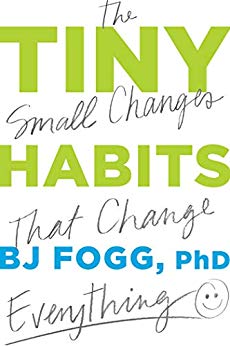More on this book
Community
Kindle Notes & Highlights
by
B.J. Fogg
Read between
December 31, 2019 - February 23, 2020
In order to design successful habits and change your behaviors, you should do three things.
Stop judging yourself. Take your aspirations and break them down into tiny behaviors. Embrace mistakes as discoveries and use them to move forward.
Behavior Design!
experimented on myself.
call this the “Information-Action Fallacy.”
I’ve found that there are only three things we can do that will create lasting change: Have an epiphany, change our environment, or change our habits in tiny ways.
With Tiny Habits, I advise people to start with three very small behaviors or even just one.
invite you to start practicing a new habit first thing each and every morning. It’s simple. And it takes about three seconds.
“It’s going to be a great day.”
recipe card,
One tiny action, one small bite, might feel insignificant at first, but it allows you to gain the momentum you need to ramp up to bigger challenges and faster progress.
simplicity changes behavior
Keeping changes small and expectations low is how you design around fair-weather friends like motivation and willpower. When something is tiny, it’s easy to do—which means you don’t need to rely on the unreliable nature of motivation.
To see a chart of all the models and methods in this book, please go to the appendix “Behavior Design: Models, Methods, and Maxims” on page 277.
My models and methods are supported by research in behavior science and evidence from related domains. You can find a large set of references at TinyHabits.com/references
In the chapters that follow I give you all the exercises you need to redesign your habits. If you want more, you can find worksheets and othe...
This highlight has been truncated due to consecutive passage length restrictions.
mindset of a Habiteer (someone who practices Tiny Habits).
EXERCISE #2: DAILY CHOCOLATE
People change best by feeling good, not by feeling bad.
Step 2: Tape the paper to your bathroom mirror or anywhere you will frequently see it.
behavior happens when the three elements of MAP—Motivation, Ability, and Prompt—come together at the same moment.
Here’s a key insight: Behaviors that ultimately become habits will reliably fall above the Action Line.
The first thing to remember is that there is no one solution for every behavior challenge.
There are two core principles that we can rely on when we analyze behavior by turning the dials of motivation, ability, and prompt.
The easier a behavior is to do, the more likely the behavior will become habit.
She told me that it takes less than three minutes for her to complete her tidying routine, which means it’s not something that is going to make her late for picking up her kids.
If you don’t have a prompt, your levels of motivation and ability don’t matter.
Learning to explain the Behavior Model quickly and clearly is one of the most useful skills in Behavior Design.
“Okay, when you turn off the shower [prompt], you grab the shower towel off the rack like this, then you put it on the
“Show me exactly what you want me to do.”
Check to see if there’s a prompt to do the behavior. See if the person has the ability to do the behavior. See if the person is motivated to do the behavior.
After I see it’s past three p.m., I will drink water instead of coffee.
After I arrive home from work, I will charge my phone in the kitchen, not in the bedroom.
After I turn on the dishwasher in the evening, I will dim the lights around the house.
After I sit down for breakfast, I will open my calendar app and review the day’s agenda.
After I walk into the office, I will smile and greet each person I see.
After I notice a meeting topic getting stuck in abstractions, I will say, “Just to clarify, we’re designing for X, right?”
After I receive a complimentary written remark, I will move the e-mail or document into my Performance Review folder.
After I turn off my computer for the day, I will file one set of papers on my desk.
After I close my office door, I will think about one accomplishment I achieved that day as I walk to the train.
After I sit down for lunch, I will launch LinkedIn to read nursing news
and get better connected.
After I feel discouraged (for any reason), I will reread my personal statement of purpose.
After my feet touch the floor in the morning, I will say, “It’s going to be an awesome day.”
After I notice my wife cleaning up the kitchen, I will give her a hug and a thank-you.


